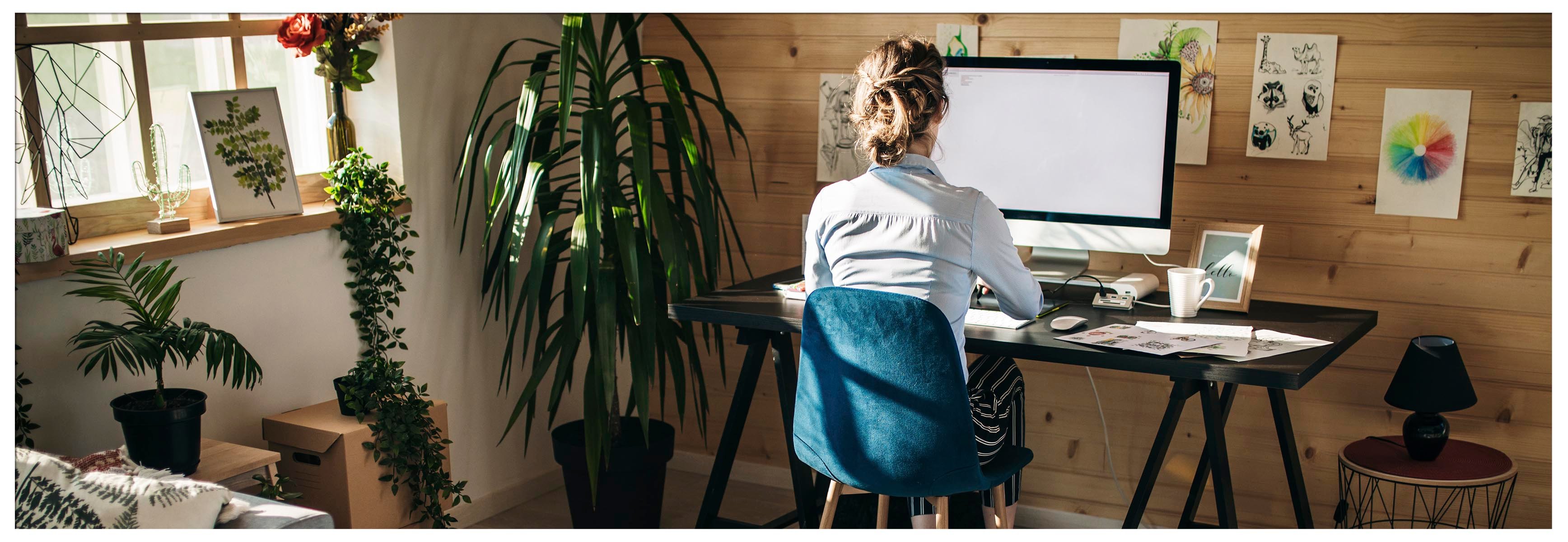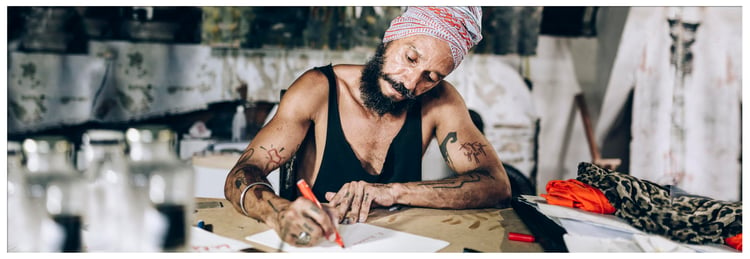
This week's offering from PRIME is from one of our amazing and talented freelancers:
Collette Hinnenkamp
Founder of Bon Temps Collective
(pictured above)
More than Just a Job
I remember sitting in my first college art class, bright-eyed and bushy-tailed, a heap of supplies piled next to me that had taken nearly all the money in my dismal account to acquire. Over the next few years, I would bounce between creative writing classrooms and art studios, filling my brain with every bit of knowledge the professors shared—form, structure, style, contrast, tension.
Many of them were successful artists themselves, whether published novelists or sought-after painters. But four years later, as I walked off with my diploma and absolutely no sense of how to make money with my trade, I realized I was missing an essential piece of knowledge. I was now in the job market, with no idea how to make a job out of my skillset.
It's not that the arts don't have a place in the business market. On the contrary, they contribute a whopping $763.6 billion to the U.S. economy. That's a Herculean contribution, my friend (more than agriculture, transportation, and warehousing, in fact). The opportunity is obviously there. The problem is there's no clear-cut path for navigating that opportunity. It's not like a law degree, per se, where you check off the necessary diplomas, pass the test, and apply to the firms that come knocking. No. The artist (who often has a nebulous plan of action at best), must hammer out their own career path from the wild woods of their industry landscape.
For yours truly, that looked like back-breaking Google searches that often led to no real answers. How do you make money as an artist? What should a novice freelancer charge?? Should you sell the rights to your art? All of these answers (and more) are required to make it as an artist.
But here's the doozy: artists are brutally competitive. Some of the most competitive professionals, I'd argue. Their work is an extension of themselves, and therefore they are sensitive at worst and very, very protective of their trade at best. What does that look like for a budding young freelance artist? An absolute lack of data. There is no Glassdoor profile for us. Our value is calculated by piecing together little bits of intel, collected by internet, word of mouth, and snooping on the competition until we think we've hit it.
It's no way to set up your profession. That's why today, I'm laying out every single best practice I can think of for freelancers and artists alike. You won't need to leave 50 tabs open on your computer, in the hopes of garnering a nugget of data here or there anymore. I'll do my absolute best never to leave you hanging with an "it depends" answer and to be as straightforward as possible.
Let's do this.

Getting Started: How To Set Your Rates as a Freelancer
I should clarify now that freelancer is an all-inclusive term that refers to writers, artists, designers, and so on. If you practice an art form that you're looking to exchange on a contract basis with others, I'm talking to you.
Setting your rate is one of the more complicated topics for freelancers, and often the one most likely to make them want to crawl under a rock. First and foremost, you have to acknowledge that it is OK that you have something to sell. You have put in the time and money to learn a skill set that someone else doesn't have. If you've done the legwork, this skillset is worth something. Let's talk about how to figure out just how much.
How to Charge: Hourly or Per Project?
Considering Charging By the Hourly Wage
A lot of new freelancers lean towards an hourly rate. It's easy to remember and talk about with prospective clients. There is also more general information about hourly rates on the internet, and so the freelancer feels they have data to back up their chosen number.
But here's the thing. If you actually want to live based on your hourly rate (without eating ramen noodles for breakfast, lunch, and dinner), it needs to be substantial enough to sustain you. Often, presenting that substantial number to a potential client can cause them to balk. After all, they only pay their employees $30 an hour, and they're salaried! Why should they pay you $150?
Here's what they're not thinking about, that you need to be. Out of that hourly rate comes much more than just your paycheck. It's also your marketing budget, your estimated taxes, your expenses, your office rent, and on and on. All of which your potential client is also spending money on, but not boxed into one hourly number.
Another aspect to consider when it comes to the hourly rate is your time. This consideration is two-fold. For one, setting an hourly rate may cause your potential client to penny-pinch on how many hours they can squeeze out of you. Odds are if you're new, you don't have a solid grasp on how long projects will realistically take you. This typically means you end up undercharging.
Second, let's consider the opposite side of the coin. Let's say you're crazy good at what you do, and you can crank out a project in no time at all. In charging by the hour, you're functionally penalizing yourself for being able to deliver quality and speed. You push out a webpage in two hours and make $300. But the same page would take a new writer down the street, five hours to write. They just made more than you for being worse at their job. Not the sweetest set-up, is it?

Considering Charging by the Project
What most professional freelancers will tell you (myself included) is that a project fee is the better route to go. This means that instead of charging by the hour for your work, you charge for the project at hand. Is it a website you're writing? A wall mural you're painting? A logo you're designing? Having a fixed project price figured out to deliver to clients does a couple of things for you.
- It makes you look like a pro. A project price shows an understanding of the complex layers and demands that will make up the project.
- It leaves less room for your client to knit pick. With a fixed project fee, the price is the price. The client can change the project aspects, but they can't how much you put into those aspects (as opposed to hours).
- Clients don't have the sticker shock of a high hourly wage.
- You can account for expenses without having to line item out your time. For instance, many freelancers give themselves a cost cushion, as projects usually end up going over in time or money. This allows you to protect yourself without having to lay every aspect of your bill.

How to Calculate Your Freelance Project Fee
How do you calculate your freelance project rate? By calculating your hourly rate. Even though you may not want to charge hourly on your bill, you should still know what you need to make per hour to make a living. Then, you'll take that number and multiply it times the estimated number of hours you know it will take you to complete the project. That, my friend, is your project fee.
So how do you know what to charge per hour? It's not as shrouded in mystery as it seems. Simply put, you work backward. Start by determining what you'd like to make a year. Be realistic here. We'd all love to live like The Great Gatsby, but your yearly salary needs to be an ethical reflection of industry standards. You'll need to do a little digging on your part. If you're a copywriter, figure out what the average copywriter in a marketing department is making. The same goes for a designer. For an artist, you'll have to do a little more guesswork. But there are still certain factors you can know going in. You're just starting out, so you need to be charging an entry level-like rate. It doesn't mean you undervalue yourself, but it does mean you don't deserve the salary of a 10-year vet. For the sake of this example, let's say you'd like to take home $60,000 a year.
Once you've got your salary, it's time to work backward. There are some really awesome calculators out there, but the basic breakdown looks like this:
-
Total all your monthly business expenses
This is everything from rent, to office supplies, to retirement. Check out this list as an excellent place to get started. For simple math, let's say they come to $10,000 annually. -
Combine that number with your desired salary
With your salary at $60,000 and expenses at $10,000, you're looking at a total of $70,000. -
Calculate the number of hours you'll work in a year
Before you bill for 40 hours a week for 52 weeks, keep in mind that only psychopaths work that much. Odds are you will be taking some vacation and possibly a sick day or two. Let's assume you take three weeks of time off a year, between vacation, sick days, and holidays. That's 21 days. At eight working hours a day, it comes to 168 hours. Now, odds are you also aren't working eight billable hours each day, either. You'll take lunch breaks, search Facebook (if we're being honest, here), and execute admin work not related to your clients. This number is personal, but let's assume it's six billable hours a day or 30 billable hours a week. -
Calculate your annual hours
-30 hours/week x 52 weeks/year= 1,560 hours a year.
-1,560 hours -168, you will be off=1,392 hours a year.
-
Calculate your hourly rate
Take your annual salary of $70,000 and divide it by your annual working hours of 1,392. Your hourly wage comes to right around $50 an hour. -
Calculate your project rate
Multiply your hourly rate to how long you believe it will take you to finish a project. That's your project fee. As you complete your first hired projects, be sure to track your time with apps like Harvest or Trello so you can ensure your estimates are accurate.
Pro Tip: If you skip this part and pick a number will-nilly, it will come back to bite you. It makes you look unprofessional when you can't explain your rates to clients who ask you. It plants seeds of doubt when you suffer from imposter syndrome. And, it is a giant red flag to clients when you can't seem to calculate changes in a project well. Spend the hour upfront. Future you will thank you.
Seriously.

Selling Your Work to the Masses
Maybe you aren't looking to work on a one-off basis. Of course, different kinds of freelancers have specific-to-them needs. If your sights are set on retail sales of any kind, what we've outlined above will be a bit different. You still need to know how much you'd like to make a year, but instead of focusing on an hourly rate, you're going to focus on profit margin and volume. There are a few different ways you can do this, so let's look at each of them.
Selling on an E-Commerce Site
Creating an e-commerce business for yourself is a great way to have recurring revenue. With this avenue, the work you do has legs. Instead of creating a piece that lives and dies in one setting, you can sell it over and over. Some of the most common outlets for this are Etsy, Shopify, or your own website.
Things to Consider with E-Commerce
While you won't be doing backward calculations about your project fees, you will be working margins backward to learn how much production will cost you and how much you need to sell for in order to make a profit. For example, let's say you want to put your art on greeting cards. You dig around online and in local boutiques to find that custom cards are usually in the $5-$6.50 range.
Now it's time to calculate your costs. Make a list of everything that will go into your product. You'll have to consider the costs of paper, printing, accompanying envelopes, clear sleeve cardholders, shipping materials, postage, etc. Of course, buying each of these things in bulk will substantially cut down on your production costs. When you go to search for each material, include the word "wholesale" in your search. A wholesaler is a company that sells blank products in bulk for a much lower rate. You'll need to set up an account with most of these, which is nothing to be wary of.
Once you have your bulk material costs, add these numbers up to a total, and divide the amount by the product total you plan to produce. This is your cost per piece. Let's say, after sourcing all your materials via wholesale, it costs you $1.75 per card. With a selling point of $6.50, that's a massive profit margin as far as a percentage is concerned. Granted, it's not tons of dough.
This means that if you want to be successful with a product that carries a small price point (regardless of how significant your profit margin is), you'll have to sell a high volume. Let's say your desired salary and expenses are the same as above ($60,000 and $10,000). At $4.75 profit per card, you're going to need to sell nearly 15,000 cards in a year to make the salary you desire.

Easing in With Drop Shippers
If it seems like way too big a risk to take, I hear you. Buying in bulk is great, except for the fact that it means you're sitting on tons of product you need to push to make a profit. If you're concerned you won't be able to sell all of the bulk product, or simply don't have the funds to create a reliable inventory, consider drop shipping to get you off the ground.
Drop shippers, like Printed Mint or Printful, carry blank products that you can purchase in one-offs. They let you upload your design, attach your branding to the packaging, and ship directly to the customer. It's less of a commitment but does carry some downsides and shouldn't be a long-term solution.
For one, the products are much more expensive than they are in bulk, and the drop shipper needs to make their money too. This eats up your profit margin quickly. You also lose control. If the package doesn't show or is wrong, there's no blaming the drop shipper. As the business owner, the buck stops with you. You'll have to right-a-wrong you didn't commit and keep the customer happy.

Selling Your Art to Retailers
Another route for selling your artwork is to sell directly to retailers who then sell your artwork in their own shop. Like e-commerce, this is a great route to go for recurring revenue, and likewise has its pros and cons. First, you've got to make sure that your production costs are low enough that you will still profit after the markup that the retailer will put on your product.
Newsflash: Most of the products you buy in-store, cost at most 50% of that cost to make, maybe a lot less.
So let's say that the retailer is going to sell your cards for the same $6.50. They will likely take 50% of the profit ($3.25). With a production cost of $1.75, now your take-home profit is $1.50. That's a lot less than when you were doing things on your own. But, what if you can sell five times as many greeting cards through the retailer? They bring exposure and reputation that you won't have yet. If you can make five times the amount, you'll more than makeup for your profit margin differences.
If you're going to approach retailers, you need to have your ducks in a row. Clare Holliday with Indie Retail Academy is by far the best resource on the internet for artists looking to get their products into retailers. She gives away gobs of free information on things like how to create a line sheet, what the heck is a line sheet, what retailers are looking for, as well as when to approach them, and more.

Licensing Your Artwork: A Do or Don't?
It's no secret that making it as an artist is tough stuff. Not only do you have to be good, but you also have to be incredibly persistent, even a little scrappy when it comes to bringing in the dough. One way to practice your passion for a living is to have multiple streams of income. One of the best ways to do this is to consider licensing out your artwork. That way, you're not only creating commissioned pieces (and perhaps selling your own products online) but also creating recurring revenue streams through artwork licensing as well. It sounds complicated, but it's pretty straightforward after a little bit of research.
Licensing your artwork usually looks like this: a company approaches you who is interested in your designs. They want to put your work on t-shirts, or maybe tote bags, phone cases, or whatever else they please. As a result, you would license out your artwork to that company to give them the right to put said artwork on their products without it being copyright infringement or stealing. This can also work in reverse.
Let's say you find an online art website that works similarly to the drop shipper we discussed earlier. You upload your prints, buyers can come on and purchase your prints, and the company will frame and ship them for you, taking a small cut for their troubles. It's an excellent opportunity to have occurring revenue in your bank account that doesn't require extra work from you in the long run. But there are a few things you need to know in order to protect yourself and license your artwork out in a way that sets you up for success, not heartache.
The first is that you should copyright your artwork. Technically speaking, once you create a piece of art, you have the intellectual copyright to that artwork as long as you can prove that it is originally your concept, but this is a very loose and risky way of doing things. The better process is to register the copyright of your artwork with the government.
That way, when you're strolling by Target and find copycats of your pieces on some lovely throw pillows, you have legal recourse against the copycatter. This is especially important if you want to put your artwork on an e-commerce site or online artwork marketplaces like Artspace, Saatchi, or Houzz. While this can gain you more visibility, it also means there are more eyes on them, some of which are hungry in the worst way. All in all, the increase in visibility means an increase in exposure to the chance a copycat will rip off your design, which unfortunately happens all too often.
OK, so you've registered your copyright. Huzzah. Next, you have got to ensure that within your contract with the interested party, there is no language about you selling the actual rights to your artwork. Unless you are creating a one-off product line specifically for a particular company, this is something you never want to do.
Selling the rights to your artwork means you give away all of the control you have over that artwork to another entity. That means that if a company buys the rights to your work and decides to print them for a few years and then stop, you wouldn't have the right to pick it back up and start selling it yourself. It means that your artwork could essentially be sitting in the depths of a computer file for decades, bringing you no income, with no avenue for you to take it into a new venture.

Collecting Royalties on the Artwork You License Out
You might be wondering, "Once I license out my artwork, how do I make money? How do I know what a fair percentage of the cut is?" The answer to the first is royalties. The second, I'm afraid, is "it depends." But don't worry, we'll break it down as much as possible.
First off, a royalty is a percentage of the artwork's sale. Think of it as your cut. How much you make in royalties depends entirely on who is buying and what the product is. If the company has massive exposure, your royalty will be smaller, but your volume will be higher. The same is true in reverse; a small boutique will have a lower volume of sales and therefore offer you a larger royalty than say, Target. As for what percentage is appropriate, that all depends on the product. Here's a simple ballpark breakdown of what you can expect depending on what you're selling:
- Greeting cards and gift wrap: 2% to 5%
- Household items such as cups, sheets, towels: 3% to 8%
- Fabrics, apparel (T-shirts, caps, decals): 2% to 10%
- Posters and prints: 10% or more
Again, the percentage will vary up and down, depending on the size of the retailer in question. Also important, these are always negotiable! Never be afraid to advocate for yourself and the quality of your work. No one else will, after all.
OK, I know that is a LOT of information. If you're still with me, congratulations, your attention span is worthy of all the gold stars. If you've dug in and now you have questions, ask me! I'd love to explain anything we covered (or didn't) in more detail for you. Let me know in the comments below!


